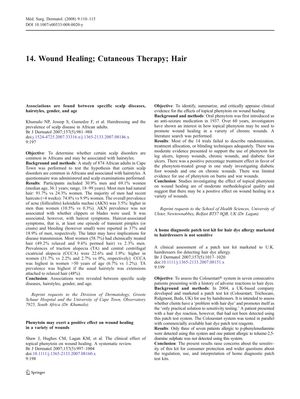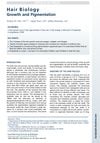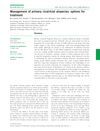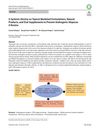Wound Healing, Cutaneous Therapy, Hair
April 2008
in “
Medical & surgical dermatology
”
androgenetic alopecia minoxidil 5% minoxidil foam phenytoin hair dye allergy test bisphosphonates calcific uremic arteriolopathy hydrogen peroxide hair graft survival 308-nm excimer laser alopecia areata TNF-α myofibroblast differentiation TGF-ß1 scar formation L-Carnitine-L-tartrate hair growth gene transcription dermal fibroblasts wound healing androgenic alopecia Rogaine hair dye test hair transplant survival excimer laser alopecia tumor necrosis factor alpha transforming growth factor beta 1 L-Carnitine hair growth supplement

TLDR Certain hairstyles can cause scalp diseases, smoking is linked to hair loss, 5% minoxidil foam is effective for hair loss treatment, and various factors influence wound healing and hair growth.
The document from 2008 summarizes research on hair and scalp conditions, wound healing, and treatments. It includes findings from a study of 874 African adults linking specific hairstyles to scalp diseases, a systematic review on the benefits of topical phenytoin for wound healing, and concerns about the sensitivity of a hair dye allergy test kit used in the UK. A survey of 740 Asian men showed a significant correlation between smoking and androgenetic alopecia. A clinical trial with 352 men confirmed the efficacy and safety of 5% minoxidil foam for treating androgenetic alopecia. Other studies reported on the potential of bisphosphonates for treating calcific uremic arteriolopathy wounds, the non-effect of hydrogen peroxide on hair graft survival, and the 41.5% success rate of a 308-nm excimer laser in treating alopecia areata on the scalp. Additional research indicated that TNF-α may impact wound healing by affecting myofibroblast differentiation, differences in TGF-ß1 responses may contribute to scar formation, and L-Carnitine-L-tartrate could promote hair growth. The document also mentioned a study on the effects of TGF-ß1 on gene transcription in human fetal versus postnatal dermal fibroblasts, suggesting that developmental differences in fibroblast response to TGF-ß1 may determine the outcome of wound healing.




